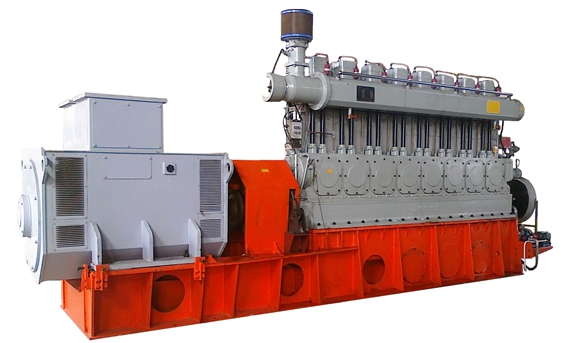水洗工藝
Washing process
因為二氧化碳和硫化氫在水中的溶解度比甲烷大����,所以水洗不但可以去除二氧化碳�,還可以去除硫化氫���。此吸收過程是純粹的物理反應(yīng)。通常沼氣通過壓縮后從吸收柱底部進入�,水從頂部進入進行反相流動吸收。吸收了二氧化碳和硫化氫的水可以再生循環(huán)使用��,可以在吸收柱中通過減壓或者用空氣吸脫再生����,當(dāng)水中的硫化氫濃度比較高的時候,一般不推薦使用空氣吹脫��,因為水很快又被硫污染����。如果有廢水可以利用,不推薦對水進行再生。
Because the solubility of carbon dioxide and hydrogen sulfide in water is greater than that of methane, water washing can not only remove carbon dioxide, but also remove hydrogen sulfide. This absorption process is a pure physical reaction. Generally, biogas enters from the bottom of the absorption column after compression, and water enters from the top for reverse flow absorption. The water absorbing carbon dioxide and hydrogen sulfide can be recycled and recycled. It can be regenerated by decompression or air absorption in the absorption column. When the concentration of hydrogen sulfide in the water is relatively high, air blowing is generally not recommended, because the water is quickly polluted by sulfur. If there is waste water available, regeneration of water is not recommended.
聚乙二醇洗滌工藝
Polyethylene glycol washing process
聚乙二醇(Selexol)洗滌和水洗一樣����,也是一個物理吸收過程。主要成分為二甲基聚乙烯乙二醇����。和在水中一樣,二氧化碳和硫化氫在Selexol中的溶解度比甲烷大���,不同之處是需要的Selexol的量比水減少��,更加經(jīng)濟和節(jié)能��。另外水和鹵化烴(填埋場沼氣中的成分)也可以用Selexol洗滌去除���。Selexol可以再生重復(fù)使用,可以使用水蒸汽或者惰性氣體(凈化后的沼氣和天然氣)吹脫Selexol中的元素硫�����,但是不推薦使用空氣�����。
Polyethylene glycol (selexol) washing is a physical absorption process just like water washing. The main component is dimethyl polyethylene glycol. As in water, the solubility of carbon dioxide and hydrogen sulfide in selexol is higher than that of methane. The difference is that the amount of selexol needed is less than that of water, which is more economical and energy-saving. In addition, water and halogenated hydrocarbon (components of landfill gas) can also be removed by selexol washing. Selexol can be regenerated and reused, and water vapor or inert gas (purified biogas and natural gas) can be used to blow off elemental sulfur in selexol, but air is not recommended.
膜分離工藝
Membrane separation process
膜法分離主要有兩種方法:一種是膜的兩邊都是氣相的高壓氣體分離;另一種是通過液體吸收擴散穿過膜的分子的低壓氣相-液相吸收分離����。
There are two main methods of membrane separation: one is the high-pressure gas separation with gas phase on both sides of the membrane; the other is the low-pressure gas-liquid absorption separation of molecules passing through the membrane by liquid absorption diffusion.

1)高壓氣相分離
1) High pressure gas phase separation
壓縮到36×105Pa的沼氣首先通過活性炭床以去除鹵化烴和硫化氫,接著便通入濾床和加熱器���。膜是由醋酸纖維素制成�����,可以用來分離像二氧化碳����、水蒸汽和殘留的硫化氫等極性分子�,它有一定的選擇性����,即在不同的區(qū)域吸收硫化氫和二氧化碳,但不能分離甲烷中的氮����。經(jīng)驗表明,膜可以持續(xù)使用三年���,在使用一年半后�����,因為萎縮的緣故����,膜的滲透性會減少30%。
The biogas compressed to 36 × 105Pa first passes through the activated carbon bed to remove the halogenated hydrocarbon and hydrogen sulfide, and then flows into the filter bed and heater. The membrane is made of cellulose acetate, which can be used to separate polar molecules such as carbon dioxide, water vapor and residual hydrogen sulfide. It has certain selectivity, that is, it absorbs hydrogen sulfide and carbon dioxide in different areas, but it can not separate nitrogen in methane. Experience has shown that the membrane can last for three years, after one and a half years of use, the permeability of the membrane will be reduced by 30% due to shrinkage.
2)氣相-液相吸收膜分離
2) Gas liquid absorption membrane separation
氣相-液吸收膜工藝近年才被用在沼氣凈化上�,其實質(zhì)是沼氣中的硫化氫和二氧化碳分子穿過一個多孔的熟睡膜在液相中被吸收去除。從下方進入的氣體�����,其中的硫化氫和二氧化碳分子能夠擴散穿過膜�,然后被相反方向流過的液體吸收,吸收膜在一個標(biāo)準大氣壓下工作��。在25℃到35℃��,可以非常有效地把沼氣中的硫化氫濃度從2%減少到小于250ppm�����,液相的吸收劑可以用NaOH溶液���。吸收了硫化氫的NaOH溶液可以應(yīng)用于水處理中以去除重金屬�。二氧化碳可以通過胺溶液作液相去除,胺溶液可以通過加熱再生���,釋放處純凈的二氧化碳可作工業(yè)應(yīng)用�����。
The gas-liquid absorption membrane technology has been used in biogas purification in recent years. Its essence is that hydrogen sulfide and carbon dioxide molecules in biogas are absorbed and removed in the liquid phase through a porous sleeping membrane. The hydrogen sulfide and carbon dioxide molecules in the gas entering from the bottom can diffuse through the membrane, and then be absorbed by the liquid flowing in the opposite direction. The absorption membrane works at a standard atmospheric pressure. From 25 ℃ to 35 ℃, the concentration of hydrogen sulfide in biogas can be effectively reduced from 2% to less than 250PPM, and NaOH solution can be used as absorbent in liquid phase. The NaOH solution absorbed hydrogen sulfide can be used in water treatment to remove heavy metals. Carbon dioxide can be removed by amine solution as liquid phase. Amine solution can be regenerated by heating. The pure carbon dioxide released can be used in industry.
